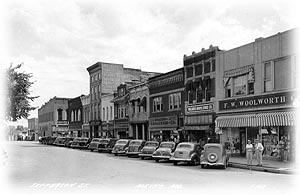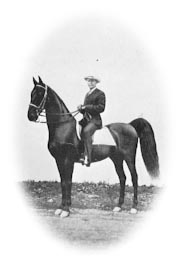 |
Audrain
County History:
Origin The County of Audrain, the 52nd in Missouri, was officially organized on December 17, 1836. Named after James H. Audrain, a member of the state legislature, it was once mostly prairie. Mexico, centrally located and the oldest town in Audrain, was designated the county seat. It was founded by two early settlers, James H. Smith and the Reverend Robert C. Mansfield. They chose the town’s name because of widespread excitement over Texas, then fighting for independence from the country of Mexico; it was the place to go to make your fortune and they were confident that the name would bring the new village good luck and "popularity." The first county court met at Mexico in February, 1837. Within two years the first court house was built on the Public Square. Early Settlers Most of the county’s early settlers came originally from Virginia, Kentucky and Tennessee. They first claimed land near woods and small streams, leaving the prairie to the east vacant. Prominent among them was John B. Morris, the first postmaster, owner of a general store, county official and operator of a tavern in Mexico. The county saw little growth over its first three decades, the population by 1850 being only 3,508. Most were farmers, while a few were regarded as "mercantile men." The one development in these early years that bore the mark of progress was the coming of the railroad. In 1856 the North Missouri, one of the state’s earliest rail lines, was laid through the county, promoting trade for the county seat and a large surrounding area. Civil War Activity During the Civil War Audrain residents were politically divided. An estimated 600 men served in the Union Army, around 500 with the Confederacy. No official battles took place on its land; one skirmish occurred. The county’s war record centers on the railroad, the occupation of Mexico and constant guerrilla warfare. Because of the railroad, Federal troops made Mexico their headquarters for most of the war. The occupying army ousted elected officials, enforced martial law, with curfew and street patrols, damaged buildings and furthered unrest throughout the county. Ulysses S. Grant, then a Colonel, was among those assigned to the area for a short time early in the war. Growing Agricultural Importance The 1870s, 1880s and 1890s brought progress and prosperity to the county. More settlers came, particularly many Germans who settled on the eastern prairie, now more easily cultivated. Additional railroad lines were built. Vandalia, Laddonia and other towns were founded and along with Mexico saw growth during these years. Farming, from its beginning the county’s main occupation, now became of primary
importance. Audrain was recognized as one of the state’s leading agricultural counties.
The chief crops were corn and oats; the main livestock were horses, mules, hogs and sheep. From the 1870s into the 1930s, an important industry developed around the American Saddle Horse, with Audrain horses regarded as the finest in the United States. Raised for riding and for "show," they were the main attraction at area fairs, drawing national attention. Outstanding among horses was Rex McDonald; achieving international renown was local black trainer and showman, Tom Bass. Audrain was called the "Saddle Horse Capital of the World." Click here to learn more about the history of agriculture in Audrain County. The Firebrick Industry Audrain also became known as the "Fire Brick Center of the World." The importance of fireclay lay in its capacity to withstand extremely high temperatures without changing form or deteriorating. It was used to build industrial furnaces and became essential to many basic industries. As early as 1883 county leaders were promoting fireclay, but it was A.P. Green and his Fire Brick Company, established in 1910, that revolutionized the industry; by 1937 his firebrick were known around the world. The Mexico Refractories Company and other smaller firebrick companies strengthened the county’s lead in this field. Audrain’s refractories companies played a major role in World War II and later in the exploration of space. Over the years the industry continued to expand and diversify, remaining a vital part of the county’s economy. Educational Advances The county has always placed great emphasis upon education. The Mexico Board of Education built the first public school in 1873. By 1900 nearly one hundred country schools had been organized, serving all rural pupils. During the 1970s these were consolidated into three school districts. For decades around the turn of the century two private institutions attracted students from across the nation. Hardin College for Young Ladies, founded in 1873, flourished until financial difficulties forced it to close in 1933. Missouri Military Academy for young men was founded in 1889. A century later it was named by the U.S. Department of Education as one of the nation’s Exemplary Private Schools. It continues to be one of the county’s valuable assets. Outstanding Audrain Countians Among Audrain’s outstanding citizens have been two Missouri governors: Charles H. Hardin (1875-77) and Christopher S. Bond (1973-77 and 1981-85). Bond, elected in 1986, is now serving in the United States Senate. Three Audrain attornies have served on the Missouri Supreme Court: George B. Macfarlane, Ernest S. Gantt and Frank B. Hollingsworth. During World War II Admiral Samuel G. Fuqua was awarded the Congressional Medal of Honor for heroism at Pearl Harbor. In the 1950s Walter G. Staley Jr. represented the United States in the Olympic Games. Many others have held prominent positions in commerce, medicine, politics and government, education, religion, business and agriculture. After a Century and a Half In 1986 Audrain County celebrated its 150th birthday. The 1990 census four years later listed seven incorporated cities besides its county seat, with a total county population of 23,599. Still one of Missouri’s leading agricultural counties, Audrain’s chief crops in the 1990s are soybeans, corn, grain sorghum and wheat, with hogs and cattle the main livestock. The firebrick industry, despite changes in company names and management, remains strong. In the 1990s the county claims four refractories companies, employing around 1,200 men and women. Along with its three public school districts and several private schools, the county once again has a college in its Advanced Technology Center. A Telecommunication Community Resource Center also serves Audrain business and industry by providing access to the most modern technology. Proud of its history, residents across the county have supported the restoration of old buildings and the preservation of significant artifacts through a number of private organizations, including the Audrain County Historical Society with its restored mansion, museums and library. |
|
|

